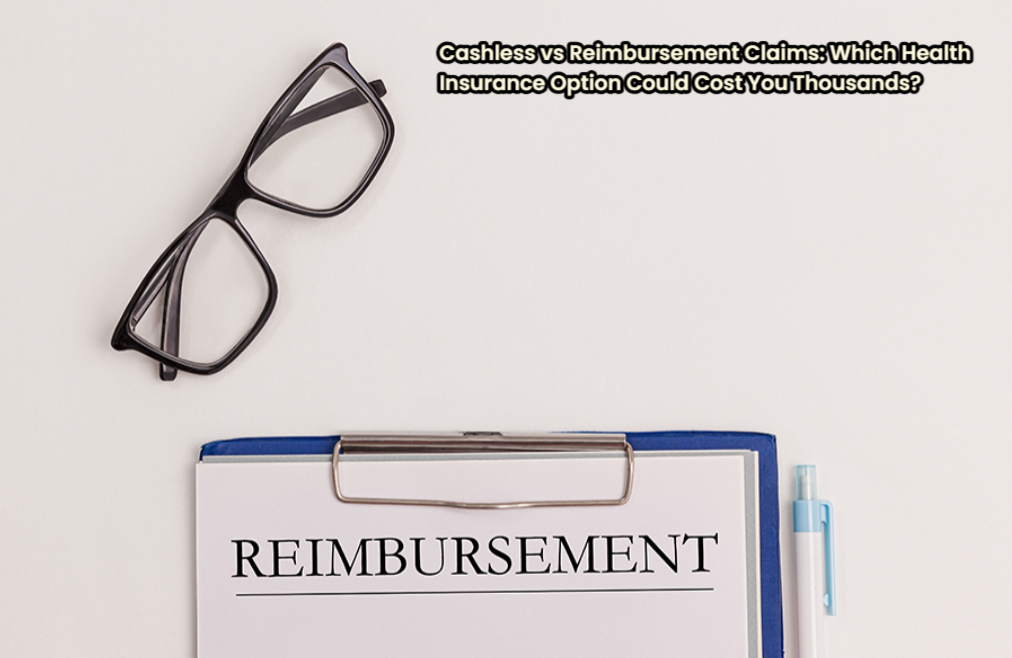When you buy a health insurance policy, you’re essentially buying peace of mind. It’s a promise that if something goes wrong with your health, you’ll have financial support to handle the medical bills. But here’s the catch—many people don’t fully understand how to use their policy when it matters most.
One of the biggest pain points for policyholders is the claim settlement process. How exactly do you get your bills paid? What if you’re admitted in an emergency? What if the hospital doesn’t support cashless insurance? The answer lies in understanding the two main types of claims under health insurance:
- Cashless Claim Settlement
- Reimbursement Claim Settlement
Both processes serve the same goal—getting your medical bills covered. But they work in very different ways. Let’s take a deep dive into each one.

What is a Cashless Claim?
Imagine you or a family member needs to be hospitalized. Your insurance company pays the hospital directly for your treatment. So, you don’t have to scramble for funds or swipe credit cards. That’s what happens in a cashless claim.
In this process, you don’t have to pay any medical expenses upfront (except for non-medical or excluded items). The insurer settles the bills directly with the hospital. It’s quick, smooth, and removes financial stress from an already difficult situation.
How does it work?
To take advantage of the cashless claim facility, you must visit a network hospital—that’s a hospital that has a tie-up with your insurance provider. These hospitals follow a pre-agreed billing and claim settlement process with the insurer.
You can usually check the list of network hospitals on the insurer’s website or mobile app.
Steps to Avail a Cashless Claim
Here’s a step-by-step guide to help you navigate the cashless claim process:
- Choose a Network Hospital: Find the nearest hospital on your insurance provider’s network list.
- Inform the Insurance Company: Let them know quickly. Ideally, do this before admission for planned procedures or within 24 hours for emergencies.
- Show Your Health Card: At the hospital insurance desk, present your health insurance card issued by the insurer.
- Pre-Authorization Form: Fill out this form provided by the hospital. This is essential for approval. The hospital will send it to the insurer.
- Claim Assessment: The insurer reviews the form and approves or denies the claim based on your policy terms.
- Treatment Begins: Once approved, you can proceed with the treatment. Post-treatment, the hospital sends final bills to the insurer.
- Payment by Insurance Company: The insurer directly pays the hospital, and you’re spared the financial burden.
Benefits of Cashless Claims
- No need to pay hefty hospital bills upfront
- Ideal for emergencies and unplanned surgeries
- Saves time and reduces paperwork
- Allows you to focus on recovery, not payments
What is a Reimbursement Claim?
Now let’s say you’re admitted to a hospital that’s not part of your insurer’s network. Or maybe it’s a small clinic or a specialty center your family doctor recommended. That’s where reimbursement claims come into play.
In a reimbursement claim, you first pay the hospital bills. Then, the insurer reimburses you for all eligible expenses based on the documents you submit.
When is Reimbursement Useful?
- When the hospital is not empanelled with your insurer
- During travel or outstation emergencies
- If a network hospital is unavailable or inconvenient
Steps to Avail a Reimbursement Claim
Here’s how you can file a reimbursement claim:
- Inform the Insurer Promptly: Let them know about the hospitalization (within 24 hours is ideal) and get a claim reference number.
- Pay the Hospital Bill: Pay all charges out of your pocket and collect all original bills, reports, and receipts.
- Collect Documents: Gather your diagnostic reports, prescriptions, discharge summary, pharmacy bills, and other important papers.
- Fill Claim Form: Complete the health insurance claim form provided by your insurer.
- Submit the Documents: Send everything to the insurance company—either online or by courier, depending on their process.
- Claim Review & Settlement: The insurer evaluates your claim. If approved, they credit the claim amount to your bank account.
Documents Required for Reimbursement Claims
To ensure smooth processing, keep these documents ready:
- Photo ID and address proof
- Policy health card
- Duly filled claim form
- Hospital discharge summary
- Final hospital bill with break-up
- Prescriptions and pharmacy bills
- Pathology and diagnostic reports
- Pre- and post-hospitalization bills (if applicable)
Cashless vs Reimbursement: What’s the Difference?
Here’s a quick side-by-side comparison to make things easier:
Feature Cashless Claim
- Reimbursement Claim
Payment Process
- Insurer pays the hospital directly.
- You pay first, then the insurer pays you later.
Hospital Type
- Only network hospitals.
- Any hospital of your choice.
Documentation
- Minimal at the hospital.
- Extensive documentation required.
Speed of Settlement
- Faster and smoother.
- Takes more time for processing.
Best For
- Planned procedures and emergencies at network hospitals.
- Non-network hospitals, remote locations, and special treatments.
👀 Common Mistakes to Avoid During Claim Process
- Not Informing the Insurer on Time: Delay in intimation can lead to claim rejection.
- Missing Documents: Incomplete paperwork slows down the reimbursement process.
- Going to a Non-Network Hospital for Cashless Claims: It won’t work—cashless is only for network hospitals.
- Ignoring Policy Limits and Exclusions: Always read the fine print; not everything may be covered.
- Always keep photocopies or scans of your bills and reports before you submit the originals.
Final Thoughts
Cashless and reimbursement claims help you manage healthcare costs easily. Which one works best depends on your situation. For planned surgeries or check-ups, go with a network hospital for a hassle-free cashless experience. But if you’re traveling or prefer a specific doctor or hospital, reimbursement gives you the flexibility you need.
Health insurance is not just about having a policy—it’s about knowing how to use it smartly. Whether it’s a fever, a fracture, or a full-blown emergency, understanding your claim options helps you act fast and stay stress-free.
Must read:
- Proven Lead Follow-Up Strategies to Help You Succeed as an Insurance Agent
- Shocking Truth: Why Your Gold Jewelry Is at Risk – Secure It NOW with the Ultimate Protection Plan!
- Can Predictive Churn Analytics Transform Insurance from Risk to Retention?
